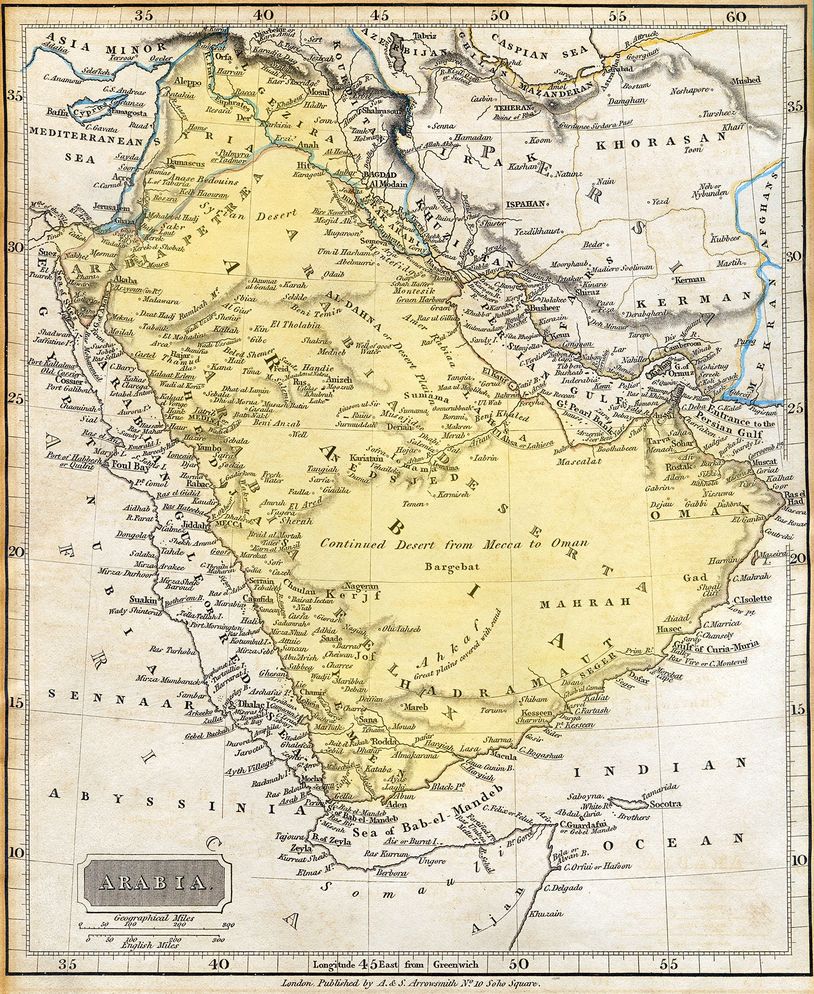ABOUT THE HOMELAND OF THE ARABIAN HORSE

ARABIA
By: Edouard Al Dahdah
The area historically known as “Arabia” is composed of the Arabian peninsula and the surrounding area to the north known as the Syrian desert. Arabia is bound to the west by the Red Sea beyond which lies Africa, to the east by the Arabian Gulf, to the northwest by the Mediterranean Sea and to the east and northeast by the mountain chains of the Taurus and the Zagros which reach up to 12,000 feet. On the west, up the back of the boot, is a mountainous region which reaches elevations of up to 8,000 to 12,000 feet in the southwest. The whole peninsula tilts like a giant wedge from the mountains of the west and southwest toward the northeast lowlands and marshes of the Arabian Gulf.
The entire western area, containing the former Kingdom of Hijaz (now a Saudi Arabian province of the same name) and the major Islamic centers of Mecca, Medina and the port at Jiddah, is rugged country, much broken by faulting. The cities of Hail, Burayda and the Saudi capital of Riyadh are located in the central highlands of the Najd plateau, an area generally inaccessible to visitors prior to the advent of modern transportation. The famous oil fields and oil cities of Dhahran and Kuwait City are located in the eastern coastal lowlands, where marshes and mudflats are not uncommon.
North of the Najd plateau lie the red sands of the Nufud desert, which extend northward toward the Hamad, or Syrian desert, and what is today Jordan and Iraq. The main horse-breeding tribes of the Anazah confederation travelled between the Nufud and what used to be called Mesopotamia—the area surrounding the Euphrates and Tigris Rivers. Major settlements in this area are Aleppo, Damascus and Homs located in present-day Syria, and Baghdad, Mosul, Basra and Najaf located in what is now Iraq.
In the years following World War I, the modern Arab countries of Saudi Arabia, Kuwait, Syria, Iraq, Lebanon, Jordan and others in southern Arabia were established, dividing up land which continued to be crossed by the tribes in their migrations until quite recent times, as nomadic life has dwindled.
Note: published in Al Khamsa Arabians III, 2008, Al Khamsa Inc. and republished with their permission.
بلاد العرب
بقلم: إدوار الدحداح
تتكون المنطقة المعروفة تاريخيًّا باسم بلاد العرب من شبه الجزيرة العربية، والمنطقة المحيطة شمالاً والتي تُعرف باسم الصحراء السورية. ويحد بلاد العرب من الغرب البحر الأحمر ويقع خلفه أفريقيا، ومن الشرق الخليج العربي، ومن الشمال الغربي البحر المتوسط، ومن الشرق والشمال الشرقي سلاسل جبال طوروس وزاجروس والتي يصل ارتفاعها إلى 12,000 قدم. ويوجد في الغرب سلسلة جبلية ممتدة يصل ارتفاعها إلى ما بين 8,000 و 12,000 قدم في الأجزاء الجنوبية . وتمتد شبه الجزيرة العربية مثل نصل عملاق من جبال الغرب والجنوب الغربي إلى الأراضي المنخفضة والسهوب في الشرق والشمال الشرقي حول الخليج العربي
أما المنطقة الغربية بأكملها، والتي تتضمن مملكة الحجاز سابقًا (وهي الآن محافظة سعودية تحمل نفس الاسم) والمراكز الإسلامية الرئيسية بمكة والمدينة، والميناء بجدة، فهي عبارة عن منطقة وعرة ذات شقوق أخدودية. في حين تقع مدن حائل والبريدة والرياض، عاصمة السعودية، في وسط المرتفعات الوسطى لهضبة نجد، وهي منطقة كان يتعذر الوصول إليها قبل ظهور وسائل النقل الحديثة. أما حقول النفط ومدينتي النفط الشهيرتين الظهران ومدينة الكويت فتقع في السهول الساحلية حيث الأراضي المنخفضة وبعض السفوح الطينية
وإلى الشمال من هضبة نجد تقع صحراء النفود برمالها الحمراء، وهي تمتد شمالاً باتجاه الحماد أو الصحراء السورية وما يُعرف اليوم بالأردن والعراق. تنقلت عشائر قبيلة العنزة، التي تعد من القبائل الرئيسية لتربية الخيل العربية، بين النفود وما كان يُطلق عليه بلاد ما بين النهرين – وهي المنطقة المحيطة بنهري الفرات ودجلة. وكانت المستوطنات الرئيسية في تلك المنطقة هي حلب، دمشق، حمص التي تقع في سوريا الحالية، وكذلك بغداد، والموصل، والبصرة والنجف التي تقع الآن في العراق
في السنوات التي أعقبت الحرب العالمية الأولى، أُنشئت الدول العربية الحديثة مثل السعودية، الكويت، سوريا، العراق، لبنان، الأردن وغيرها من الدول في جنوب وشرق بلاد العرب، الأمر الذي أدى إلى تقسيم هذه البلاد والتي استمرت القبائل العربية في عبورها أثناء هجراتها حتى وقت قريب جدًا إلى أن تلاشت حياة البدو
ملحوظة: المقال من كتاب: Al Khamsa Arabians III, 2008, Al Khamsa Inc. ويعاد نشره وترجمته بإذن منهم. ترجمة د. شيرين القباني
Copyright © 2022 The Arabian Horse Manifesto - All Rights Reserved.
Powered by GoDaddy